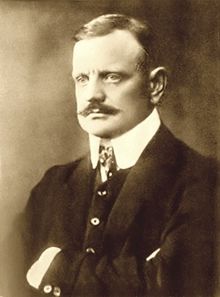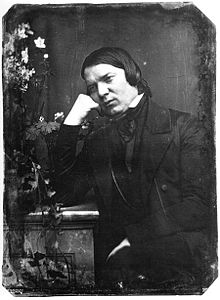Music Director Michael Tilson Thomas led the San Francisco Symphony in a great, very great performance of the Violin Concerto in D minor, Opus 47, by Jean Sibelius, and Symphony No. 3 in E flat major, Opus 97, Rhenish, by Robert Schumann, November 13-15, at Davies Hall. If by any chance you missed hearing one of these concerts, you have a chance for more Sibelius tonight, Nov. 18, when pianist Leif Ove Andsnes performs works of Sibelius, Beethoven, Debussy, and Chopin. And, another chance for a grand Schumann symphony, Nov. 19-21, when MTT and the SFS perform Schumann’s symphony, No. 1, Spring.
 This is the 150th anniversary of Jean Sibelius’s birth, Dec. 8, 1865. Thanks to the milestone quality of that event, the SFS and others are performing more of his extraordinary music. One may hear Finlandia on the radio from time to time, and its stirring beauty is ample reason for Finland to celebrate Sibelius as a national hero, but he did write more. This program opened with his tone poem, The Swan of Tuonela, Opus, 22, no. 2. Written in 1896, it is one of a group of works based on Finnish legends, Four Legends from the Kalevala. Its beauty is misty, ethereal, and even a bit eerie. Tuonela was the “land of death” in Finnish myths. The Swan of Tuonela floats on a large river which circles Tuonela and sings. The images of the tale evaporate into the music or the music calls the mythic characters into being. From which ever direction one experiences it, The Swan of Tuonela, as performed by the SFS is beautiful and chilling.
This is the 150th anniversary of Jean Sibelius’s birth, Dec. 8, 1865. Thanks to the milestone quality of that event, the SFS and others are performing more of his extraordinary music. One may hear Finlandia on the radio from time to time, and its stirring beauty is ample reason for Finland to celebrate Sibelius as a national hero, but he did write more. This program opened with his tone poem, The Swan of Tuonela, Opus, 22, no. 2. Written in 1896, it is one of a group of works based on Finnish legends, Four Legends from the Kalevala. Its beauty is misty, ethereal, and even a bit eerie. Tuonela was the “land of death” in Finnish myths. The Swan of Tuonela floats on a large river which circles Tuonela and sings. The images of the tale evaporate into the music or the music calls the mythic characters into being. From which ever direction one experiences it, The Swan of Tuonela, as performed by the SFS is beautiful and chilling.
 Leonidas Kavakos performed the Violin Concerto (1904) with stunning virtuosity. This is not stunning in the sense of “looking good.” This was stunning in the sense of shivers up the back bone and eye popping brilliance. Mr. Kavakos made the first recording of the original version of this Violin Concerto, in 1991. That version is said to be even more demanding than the one more often performed. The winner of major international violin competitions, he is far more than a majestic technician; he is a magical musician. The concerto moves from very delicate, dream-like music into deeply passionate music with the full orchestra. As a moody, pessimistic sound takes over, the solo violin emerges to play an astonishing cadenza. Sibelius uses the voices of the orchestra and of the soloist in opposition and also brilliant unity. As a composer, Sibelius can only be described as Sibelius-esque. The music finds enchanting melody and also heart pounding syncopated rhythms. This SFS performance with Leonidas Kavakos took one’s breath away.
Leonidas Kavakos performed the Violin Concerto (1904) with stunning virtuosity. This is not stunning in the sense of “looking good.” This was stunning in the sense of shivers up the back bone and eye popping brilliance. Mr. Kavakos made the first recording of the original version of this Violin Concerto, in 1991. That version is said to be even more demanding than the one more often performed. The winner of major international violin competitions, he is far more than a majestic technician; he is a magical musician. The concerto moves from very delicate, dream-like music into deeply passionate music with the full orchestra. As a moody, pessimistic sound takes over, the solo violin emerges to play an astonishing cadenza. Sibelius uses the voices of the orchestra and of the soloist in opposition and also brilliant unity. As a composer, Sibelius can only be described as Sibelius-esque. The music finds enchanting melody and also heart pounding syncopated rhythms. This SFS performance with Leonidas Kavakos took one’s breath away.
 Robert Schumann (1810-1856) was a pianist, conductor, music critic, journalist in addition to being a great composer. We are all lucky that MTT and the SFS are launching a project to record Schumann’s four symphonies. The performance, Nov. 15, was the first of the performance recordings. It was glorious. Maestro Tilson Thomas captured the energy and motion of the music. One could almost feel the rolling power of the water in the waves of sound. The SFS played as though their hearts were unleashed. The symphony opens with lively music; we are there on the Rhine, that ever present symbol of Europe. The second movement has the rhythms of dances. The minuet and a German folk dance combine. Schumann had called it “Morning on the Rhine.” He and his wife, Clara, had taken a trip to the Rhineland together and remembered it as a tranquil, happy time. Schumann had seen the cathedral at Cologne and the installation of a Cardinal there. The solemnity of the fourth movement is his representation of the grandeur of the place and event. In the end, wisps of the early themes reappear; the timing slows as the great river swells and travels toward the sea. The the symphony has an internal effect on the listeners. The audience was buoyant, energized, smiling as though the movement of the music had infused them all with the spirit of the natural force of the river.
Robert Schumann (1810-1856) was a pianist, conductor, music critic, journalist in addition to being a great composer. We are all lucky that MTT and the SFS are launching a project to record Schumann’s four symphonies. The performance, Nov. 15, was the first of the performance recordings. It was glorious. Maestro Tilson Thomas captured the energy and motion of the music. One could almost feel the rolling power of the water in the waves of sound. The SFS played as though their hearts were unleashed. The symphony opens with lively music; we are there on the Rhine, that ever present symbol of Europe. The second movement has the rhythms of dances. The minuet and a German folk dance combine. Schumann had called it “Morning on the Rhine.” He and his wife, Clara, had taken a trip to the Rhineland together and remembered it as a tranquil, happy time. Schumann had seen the cathedral at Cologne and the installation of a Cardinal there. The solemnity of the fourth movement is his representation of the grandeur of the place and event. In the end, wisps of the early themes reappear; the timing slows as the great river swells and travels toward the sea. The the symphony has an internal effect on the listeners. The audience was buoyant, energized, smiling as though the movement of the music had infused them all with the spirit of the natural force of the river.
 Three cheers for MTT’s Schumann project with the San Francisco Symphony. This great, Romantic composer has not been given his due in recent decades. Music lovers should not miss this experience. The time has come to rediscover his music.
Three cheers for MTT’s Schumann project with the San Francisco Symphony. This great, Romantic composer has not been given his due in recent decades. Music lovers should not miss this experience. The time has come to rediscover his music.
Pictures, from top: Jean Sibelius; Leonidas Kavakos, courtesy of San Francisco Symphony; Robert Schumann, photograph from 1850; Michael Tilson Thomas, courtesy of San Francisco Symphony.